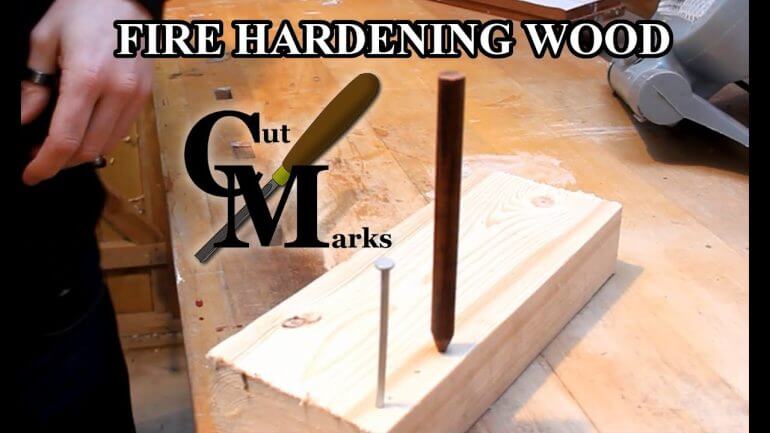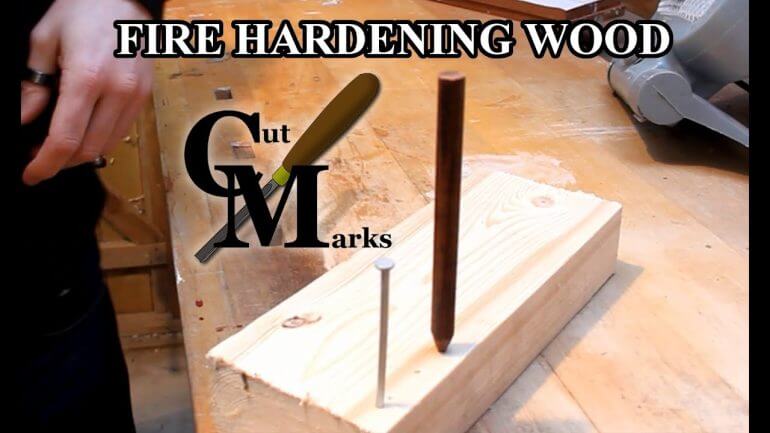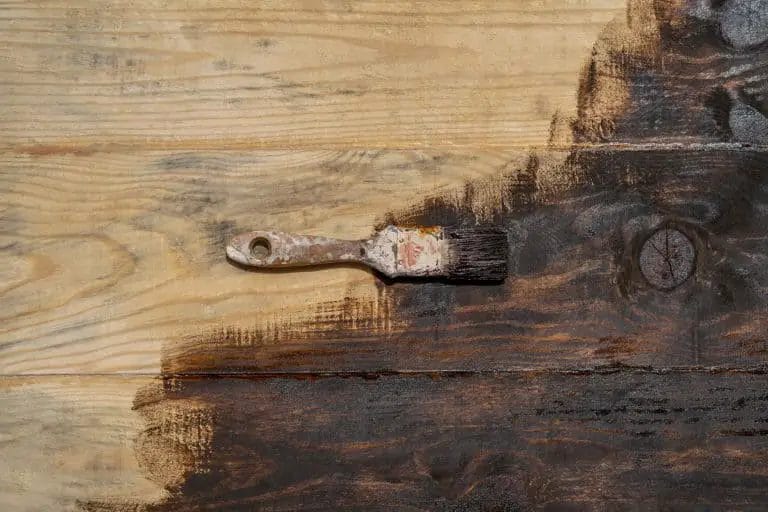If you’re looking to enhance the durability and strength of wood, hardening it is a smart solution. By applying various methods and products, you can significantly increase the resistance of wood to factors such as moisture, wear, and damage.
One effective method to harden wood is through the use of sealants or finishes. These products create a protective layer on the surface of the wood, preventing moisture penetration and reducing the risk of warping or swelling.

In addition to sealants, another way to harden wood is by using epoxy resin. This versatile material not only strengthens the wood but also provides a glossy and smooth finish. It fills any cracks or holes in the surface, creating a more robust and resilient structure.
Another popular method for wood hardening is the application of wood petrifier products. These solutions infiltrate the wood fibers, chemically altering them and turning them into a harder substance. This process improves the wood’s resistance to decay, pests, and general wear.
Lastly, heat treatment is an effective technique for hardening wood. By exposing the wood to high temperatures, the lignin in the cellular structure partially breaks down, resulting in a stronger and more stable material. However, it’s important to carefully control the temperature and duration to prevent damage or excessive drying.
Overall, by employing these methods and products, you can successfully increase the hardness and durability of wood, making it suitable for

Essential Steps for Increasing Wood Durability
Ensuring the durability and longevity of wood is crucial in various applications, from furniture and flooring to outdoor structures like decks and fences. By taking the necessary steps to increase wood durability, you can enhance its resistance to decay, pests, and wear, ultimately prolonging its lifespan. In this section, we will explore some essential steps you can follow to effectively increase the durability of wood.
1. Proper Wood Selection
The first step in increasing wood durability is to select the right type of wood. Certain wood species naturally possess better resistance to decay and pests. Hardwoods such as teak, cedar, and redwood are known for their durability, while treated softwoods like pressure-treated pine offer enhanced resistance against rot and insect infestation.
2. Wood Drying
Wood contains moisture, and excess moisture can lead to decay and fungal growth. Proper wood drying is crucial in increasing its durability. The two primary methods of wood drying are air drying and kiln drying. Air drying involves stacking and exposing the wood to natural air circulation for an extended period. Kiln drying, on the other hand, utilizes artificial heat and controlled humidity to speed up the drying process. Whichever method you choose, ensuring that the wood reaches an optimal moisture content is essential.
3. Wood Preservatives
Using wood preservatives is another effective step in increasing wood durability. These products contain chemicals that protect the wood against decay, fungi, and insect damage. There are various types of wood preservatives available, including oil-based, water-based, and borate-based preservatives. The choice of preservative depends on the wood species, application, and desired level of protection.
4. Proper Installation and Maintenance
The way wood is installed and maintained also plays a vital role in its durability. Proper installation techniques, such as providing adequate ventilation and avoiding direct ground contact, can prevent moisture buildup and minimize the risk of decay. Regular maintenance practices like cleaning, sealing, and refinishing can further protect the wood from wear, weathering, and UV damage.
5. Avoidance of Moisture Traps
Moisture is the enemy of wood durability, so it’s essential to avoid moisture traps. Ensure proper drainage around wooden structures, preventing water from pooling and causing prolonged exposure to moisture. Additionally, using proper flashing and sealing techniques in construction can help keep water out and protect the wood from moisture-related issues.
6. Pest Prevention
Pests like termites and carpenter ants can significantly impact wood durability. Implementing pest prevention measures is crucial to safeguarding the wood. This can involve using pest-resistant wood species, applying appropriate insecticides, and regular inspections to detect and address any pest infestations promptly.
7. Regular Inspections
Regular inspections are essential to identify any signs of wood decay, insect damage, or structural issues. By conducting thorough inspections and promptly addressing any problems, you can prevent further deterioration and ensure the longevity of the wood.
By following these essential steps, you can significantly increase the durability of wood and ensure its longevity in various applications. Proper wood selection, drying, and treatment, along with diligent installation, maintenance, and inspections, will help you maximize the lifespan and performance of wood products.

Effective Methods for Fortifying Softwoods and Hardwoods
Wood is a versatile and renewable building material that has been used for centuries. However, one of the main drawbacks of wood is its susceptibility to damage and decay. Softwoods and hardwoods are particularly vulnerable to pests, moisture, and general wear and tear. To address these concerns, there are several effective methods for fortifying both softwoods and hardwoods, ensuring their longevity and durability. In this section, we will explore some of these methods in detail.
1. Pressure Treatment
Pressure treatment is a widely used method for fortifying softwoods and hardwoods. This process involves placing the wood in a pressure chamber and injecting it with preservatives. The pressure forces the preservatives deep into the wood fibers, providing enhanced protection against decay, insects, and fungi. The chemicals used in pressure treatment can vary, but commonly employed ones include copper-based compounds, borates, and creosote.
Pressure-treated wood is commonly used for outdoor applications such as decking, fencing, and landscaping structures. It offers excellent resistance to rot and insect damage, significantly extending the lifespan of the wood.
2. Heat Treatment
Heat treatment is another effective method for fortifying both softwoods and hardwoods. This process involves heating the wood to high temperatures in a controlled environment. The heat alters the wood’s cellular structure, reducing its moisture content and making it less susceptible to decay and insect infestation.
Heat-treated wood, also known as thermally modified wood, has improved dimensional stability, increased durability, and enhanced resistance to rot and insects. It is commonly used in applications such as outdoor furniture, cladding, and interior flooring.
3. Chemical Treatments
Chemical treatments involve applying protective coatings or treatments to the wood surface to enhance its resistance to moisture, rot, and insects. Some common chemical treatments include:
- Paints and Stains: Applying a layer of paint or stain to the wood creates a barrier that protects it from moisture and UV damage. Additionally, certain stains contain preservatives that help deter insect infestations.
- Waterproofing Sealers: Waterproofing sealers penetrate the wood, forming a protective barrier against moisture. These sealers are commonly used for outdoor wooden structures, such as decks and fences.
- Wood Preservatives: Wood preservatives are chemical solutions that are applied to the wood to prevent decay, insect attack, and fungal growth. There are different types of preservatives available, including oil-based, water-based, and borate-based treatments.
Chemical treatments can significantly enhance the durability and lifespan of both softwoods and hardwoods, making them suitable for a wide range of applications.
4. Laminating and Veneering
Laminating and veneering involve bonding thin layers of wood together to create a stronger, more durable material. This process is commonly used for countertops, furniture, and decorative applications. By combining multiple layers of wood with adhesives, the resulting laminated or veneered wood has increased resistance to splitting, warping, and impact damage.
In addition, laminating and veneering allow for greater design flexibility, as different wood species or patterns can be used to achieve a desired aesthetic.
5. Wood Treatments with Epoxy Resin
Epoxy resin is a versatile material that can be used to fortify softwoods and hardwoods. By impregnating the wood with epoxy resin, it becomes stronger, more resistant to moisture, and less prone to decay and insect damage.
Epoxy-treated wood is commonly used in marine applications, outdoor furniture, and structural repairs. The resin fills in the pores and voids of the wood, creating a solid and durable material.
Summary
Fortifying softwoods and hardwoods is essential to ensure their longevity and durability. Pressure treatment, heat treatment, chemical treatments, laminating and veneering, and wood treatments with epoxy resin are all effective methods for enhancing the strength and resistance of wood. By employing these methods, wood can withstand the challenges of pests, moisture, and general wear and tear, making it a reliable and sustainable building material for various applications.

Top Tips for Enhancing the Strength and Resistance of Wooden Surfaces
Wood is a versatile and timeless material that adds warmth and beauty to any space. However, over time, wooden surfaces can become worn out and susceptible to damage. If you want to enhance the strength and resistance of your wooden surfaces, here are some top tips to consider:
1. Choose the Right Type of Wood
The first step in ensuring the strength and resistance of your wooden surfaces is to choose the right type of wood. Different wood species have varying levels of hardness and durability. Hardwoods like oak, maple, and teak are known for their strength and resistance to wear and tear. Softwoods like pine and cedar are less durable, but can still be strengthened through proper treatment and maintenance.
2. Apply Protective Finishes
To enhance the resistance of your wooden surfaces, it is crucial to apply protective finishes. These finishes not only provide a protective layer against moisture, UV rays, and daily wear, but also enhance the overall strength of the wood. Options for protective finishes include varnishes, polyurethane, lacquer, and oils. Choose a finish that suits your specific needs and follow the manufacturer’s instructions for application.
3. Regular Cleaning and Maintenance
Maintaining the cleanliness and condition of your wooden surfaces is key to their longevity. Regularly dusting and cleaning the surfaces with a mild cleaning solution and a soft cloth can prevent the buildup of dirt and grime. Avoid using harsh chemicals or abrasive materials that can scratch or damage the wood. Additionally, inspect the surfaces for any signs of wear or damage and address them promptly to prevent further deterioration.
4. Protect from Moisture and Humidity
One of the biggest enemies of wooden surfaces is moisture. Moisture can cause the wood to warp, rot, or develop mold and mildew. To protect your wooden surfaces, ensure that they are properly sealed with a waterproof finish. Additionally, avoid placing them in areas with high humidity or direct exposure to water, such as bathrooms or near windows without proper insulation. Use coasters or placemats to prevent water rings and spills.
5. Avoid Excessive Heat and Sunlight
Excessive heat and sunlight can also damage wooden surfaces over time. Direct sunlight can cause the wood to fade and dry out, while extreme heat can lead to warping and cracking. To protect your wooden surfaces, place them away from direct sunlight or use window treatments like blinds or curtains to block the UV rays. Use heat-resistant mats or trivets under hot objects to prevent heat damage.
6. Repair and Refinish as Needed
If your wooden surfaces do experience any form of damage or wear, it is essential to address it promptly. Small scratches or dents can be repaired using wood fillers or touch-up kits. For more significant damage, such as deep scratches or water stains, consider refinishing the surface to restore its strength and appearance. Sanding, staining, and applying a new finish can breathe new life into worn-out wooden surfaces.
In summary, by choosing the right type of wood, applying protective finishes, regular cleaning and maintenance, protecting from moisture and humidity, avoiding excessive heat and sunlight, and repairing and refinishing as needed, you can significantly enhance the strength and resistance of your wooden surfaces. With proper care, your wooden surfaces can maintain their beauty and functionality for years to come.
Expert advice on preventing wood damage and decay
Wood is a natural and versatile material that can be found in many aspects of our daily lives, from furniture to buildings. However, it is susceptible to damage and decay if not properly cared for. In this section, we will provide you with expert advice on how to prevent wood damage and decay, ensuring the longevity of your wooden structures and belongings.
1. Protect wood from moisture
Moisture is the primary enemy of wood, as it can lead to rot, mold, and insect infestation. To prevent moisture damage, make sure to:
- Keep wood away from direct contact with the ground or any sources of standing water.
- Use proper drainage systems around wooden structures to divert water away.
- Apply a water-resistant sealant or paint to protect the wood’s surface.
- Regularly inspect and repair any leaks in pipes or roofs that may cause water to seep into the wood.
2. Control humidity levels
High humidity can cause wood to expand and contract, leading to warping and cracking. To control humidity levels:
- Use dehumidifiers or air conditioners to maintain a consistent humidity level in your home or storage areas.
- Ensure proper ventilation in areas with wooden structures to allow moisture to escape.
- Avoid placing wood furniture or items in areas prone to excessive moisture, such as basements or bathrooms.
3. Regularly clean and maintain wood
Regular cleaning and maintenance play a crucial role in preventing wood damage and decay. Follow these tips:
- Dust wooden surfaces regularly to remove dirt, debris, and potential food sources for pests.
- Use a mild detergent and water to clean wooden furniture or structures, avoiding harsh chemicals that can damage the wood.
- Apply a quality wood polish or conditioner to keep the wood hydrated and protected.
- Inspect wood for signs of damage or decay, such as soft spots, discoloration, or fungal growth, and take immediate action to address the issue.
4. Apply protective coatings
Adding a protective coating to wood surfaces can enhance durability and prevent damage. Consider these coatings:
- Paint: A layer of paint protects wood from moisture and UV rays, preventing decay and color fading.
- Stain: A wood stain adds color and protects against moisture, UV rays, and mildew.
- Varnish: Varnish provides a hard protective layer against scratches and moisture, ideal for high-traffic areas.
- Sealant: A sealant forms a barrier against water penetration, ideal for exterior wood surfaces.
5. Regularly inspect and treat for pests
Pests like termites and wood-boring beetles can cause significant damage to wood. Take the following measures:
- Regularly inspect wood for signs of pest infestation, such as small holes, sawdust, or tiny pellets.
- Apply appropriate pesticides or contact a professional pest control service if an infestation is detected.
- Consider using pressure-treated or naturally insect-resistant wood for areas prone to pest activity.
In summary, preventing wood damage and decay requires proper care, maintenance, and protection from moisture, humidity, pests, and other damaging factors. By following the expert advice provided in this section, you can ensure the longevity and beauty of your wooden structures and belongings.
FAQs
Q: How can I harden wood?
To harden wood, you can use various methods such as heat treatment, chemical treatment, or compression. Heat treatment involves heating the wood at high temperatures to increase its hardness. Chemical treatments like using borate solutions can also harden wood. Compression can be achieved by using pressure to compact the wood fibers, making it denser and harder.
Q: Can I harden wood naturally without using chemicals?
Yes, you can naturally harden wood without the use of chemicals. One method is air-drying, where you allow the wood to dry slowly over time, which increases its hardness. Another natural method is to expose the wood to sunlight, which can help enhance its hardness. However, natural hardening methods may take longer compared to chemical treatments.
Q: Are there any specific types of wood that are naturally harder?
Yes, certain types of wood are naturally harder than others. Some examples include hardwoods like oak, maple, and mahogany. These types of wood have a higher density and natural hardness, which makes them more resistant to dents and scratches. So, if you are looking for a naturally hard wood, consider using hardwood species.
Conclusion
In conclusion, knowing how to harden wood can greatly enhance its durability and longevity. By following the proper techniques and using the right materials, you can transform softwood into a hard and robust material. Whether you are working on a DIY project or involved in professional woodworking, hardening wood can make a significant difference in the quality of your final product.
Remember to always start with the necessary preparation, such as sanding, cleaning, and drying the wood properly. Then, choose the appropriate wood hardening product based on your specific needs and desired result. Apply the hardener evenly and allow it to cure fully according to the manufacturer’s instructions. Finally, finish the hardened wood with a protective sealant or varnish to provide additional strength and resistance to wear and tear.
By mastering the art of hardening wood, you can enjoy the beauty and strength of this versatile natural material for years to come.